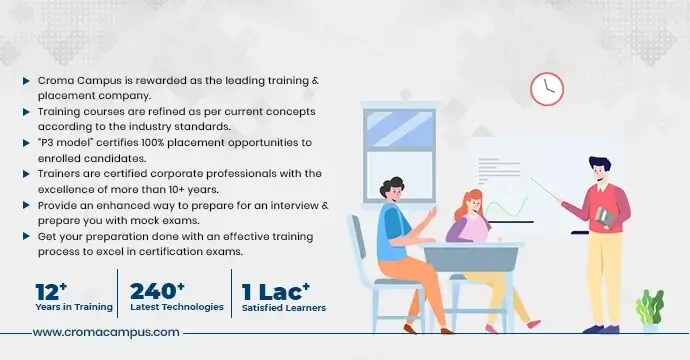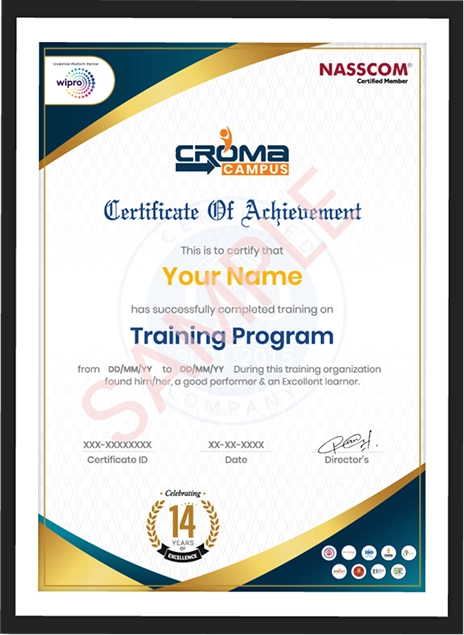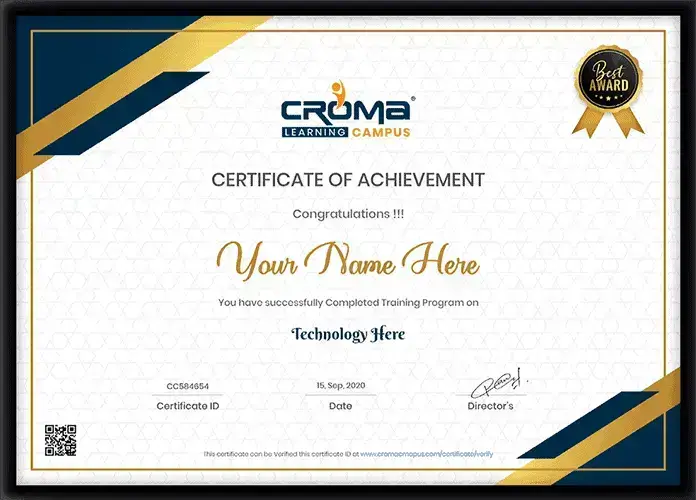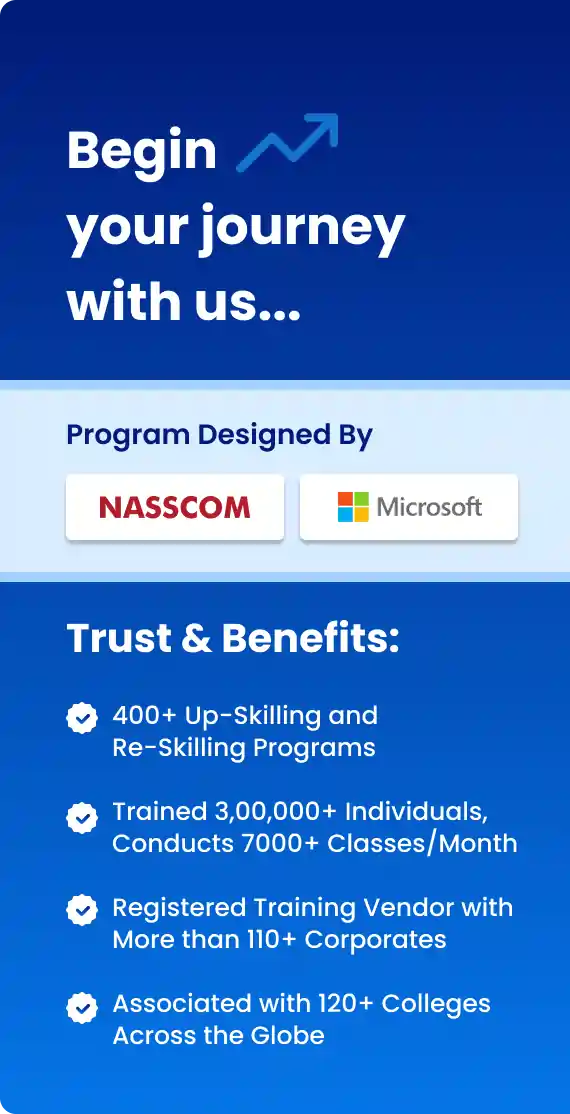Course Design By
Nasscom & Wipro
Home /Frontend Development/ UI UX Course Online Training in India
Master the key concepts of Ui Ux Training Course. Enroll today to learn from a skilled UI/UX designer.
In collaboration with

120 Hrs.
Duration
Online/Offline
Format
LMS
Life Time Access
we train you to get hired.


In order to design with intention, you must first understand the definition and principles of UI/UX Design.
Obtain a thorough understanding of the whole design life cycle, including the method, purpose, and tools.
Learn the fundamentals of HCI (human-computer interaction) and the psychology that drives user behavior.
Discover the industry-standard tools and specific project deliverables in UI/UX.
Explain why you made design decisions, through presentations of assignments and your personal portfolio.
A UI designer with less than a year of experience can expect to earn roughly INR 300,000 per year.
An early starter (with 1-4 years of experience) might expect to earn around INR 425,000 per year.
With 5-9 years of experience, a UI designer can expect to make around INR 720,000 per year.
A UI designer with 10 to 15 years of expertise can expect to earn INR 900,000 or more.
Understanding business requirements and user feedback to create user-centred designs.
User flows, wireframes, prototypes, and mockups are all things that you need to perform.
Creating style guides, design systems, design patterns, and appealing user interfaces from requirements.
UI features including input controls, navigational components, and informational components are designed.
Developing unique graphic designs (e.g., images, sketches and tables).
Identifying and resolving user experience issues (e.g., responsiveness).
Effectively collaborating with product, engineering, and management teams.
Customer feedback, usage analytics, and usability discoveries are incorporated into the design to improve the user experience.
we train you to get hired.

By registering here, I agree to Croma Campus Terms & Conditions and Privacy Policy
Module 1: Introduction to Photoshop
Module 2: Navigation and Resolution . Zooming an Image
Module 3: Rotate and Crop
Module 4: Color Correction
Module 5: Painting with the Edit Tools
Module 6: Red Eye Removal and Recolor
Module 7: Clone, Heal, and Patch
Module 8: Using the Selection Tools
Module 9: Selecting with Color Range
Module 10: Making the Most of History
Module 11: Introducing Layers
Module 12: Groups and Comps
Module 13: Opacity and Blend Modes
Module 14: Advanced Blending
Module 15: Layer Styles
Module 16: Masks and Channels
Module 17: Transform and Warp
Module 18: Creating and Editing Type
Module 19: Special Type Effects
Module 20: Vector-based Shapes
Module 21: Printing and Output
Module 22: Actions
Module 23: Adjusting Levels
Module 24: Curves, Shadows, & Highlights
Module 25: Adjustment Layers
Module 26: Sharpening Focus
Module 27: Blurring and Averaging
Module 28: Filters and Masks
Module 29: Distort and Displace
Module 30: Liquify
Module 31: Vanishing Point
Module 32: Smart Objects
Module 33: Web Application and Animation
Module 1: Introducing Illustrator
Module 2: Workspace & Navigation
Module 3: Symetrical Shapes
Module 4: Fill Stroke and Color
Module 5: Transforming Paths
Module 6: Using the Powerful Pen Tool
Module 7: Selecting Points and Paths
Module 8: Pathfinder Operations
Module 9: Liquify & Envelope
Module 10: Gradients & Gradient Mesh
Module 11: Blends and Masks
Module 12: Creating and Formatting Type
Module 13: Brushing with Vectors
Module 14: Using Transparency
Module 15: Introducing Live Effects
Module 16: Dynamic Type Treatments
Module 17: Live Trace
Module 18: Live
Module 19: Using Symbols
Module 20: 3D Effects
Module 21: Printing & Exporting
Module 22: Flash Animation
Module 1: FIGMA Fundamentals
Module 2: Learn about FIGMA Interface
Module 3: Setting up a New Project
Module 4: Add and Edit Content
Module 5: Completing the Design
Module 6: Prototyping, Sharing, and Exporting
Module 7: Advanced FIGMA Concepts
+ More Lessons
Course Design By
Nasscom & Wipro
Course Offered By
Croma Campus
Stories
success
inspiration
career upgrade
career upgrade
career upgrade
career upgrade
You will get certificate after
completion of program
You will get certificate after
completion of program
You will get certificate after
completion of program
in Collaboration with

Empowering Learning Through Real Experiences and Innovation
we train you to get hired.
Phone (For Voice Call):
+91-971 152 6942WhatsApp (For Call & Chat):
+919711526942Get a peek through the entire curriculum designed that ensures Placement Guidance
Course Design By
Course Offered By
Ready to streamline Your Process? Submit Your batch request today!

Croma Campus is very nice training center. I learned HTML,CSS,PHP and Frameworke training in Croma Campus. He is very experience and way of teaching is very good. I got the job based on training,It was my great experience from Croma Campus. All the tutors were very knowledgeable and supportive, the Read more...

Got placed in Spark Info systems. Good training Of Vimal Sir and awesome placements of Akansha Mam. Joining Croma Campus was a good decision Read more...

Nice place to learn practical things on Graphics Design. They helped me to gain some tactics and real knowledge about Web Designing . The Environment was good with the Expert trainers. Read more...

Croma Campus is the best place to learn about Node JS. I had a very amazing learning experience with these people. Read more...

By Joining the WordPress training program of Croma Campus you can become a WordPress expert in a short time. My learning experience has been amazing with Amrish sir. Thanks sir for everything. Read more...

Hi. My name is Gaurav Sharma from Noida. After enrolling into the Croma campus, I have lot of good experience in learning. The faculty, interior, proper facilities are available. The classes were held in online mode which gave me the benefit of not stepping out from home. The trainer helped in maki Read more...

Hello. I completed my certification from Croma Campus which provide me with great skills and knowledge. My overall experience was good. All the whole faculty, trainer, and counselor were there to help in completing the course. Read more...

Croma Campus is the best name for offering technical education. If we talk about my UI-UX training then it was a great experience for me. After training completion, I got a lot of calls from various reputed organizations. Read more...

This's really a good initiative to keep the peoples educated in the new technologies and thereby improve their knowledge. This also provides a great opportunity for people to develop their careers. Read more...
Croma Campus is the well-known UI UX Design Course with Placement in India. We provide training by industry experts.
Croma Campus provides placement-focused UI UX courses by experienced professionals.
No prior experience is typically required for beginner courses. Many programs are designed to cater to all skill levels, including complete beginners.
The duration of courses can vary widely. Some boot camps may last around 9 months, while shorter courses or workshops may take just a few weeks to complete.
Most accredited UI UX courses offer a certificate of completion, which can be beneficial when applying for jobs in the field.
For details information & FREE demo class call us on +91-9711526942 or write to us info@cromacampus.com Address: - G-21, Sector-03, Noida (201301)

Highest Salary Offered
Average Salary Hike
Placed in MNC’s
Year’s in Training

fast-tracked into managerial careers.
Get inspired by their progress in the
Career Growth Report.
FOR QUERIES, FEEDBACK OR ASSISTANCE
Best of support with us





An OTP on your submit Mobile No has been shared.please check and submit OTP

We’re the best training provider with rigorous industry-relevant programs designed and delivered in collaboration with world-class faculty, industry & Infrastructure.
Share some of your details and we will be in touch with you for demo details, and know about Batches Available with us!
By registering here, I agree to Croma Campus Terms & Conditions and Privacy Policy



Enter your email and phone number
For Voice Call
+91-971 152 6942For Whatsapp Call & Chat
+91-9711526942Talk to Career Counsellor

Stay ahead in your career with real-time salary updates.
By registering here, I agree to Croma Campus Terms & Conditions and Privacy Policy

We’re the experts in web design and development for the start up next door and the fortune 500.

What Benefit You will get from this Program
By registering here, I agree to Croma Campus1 Terms & Conditions and Privacy Policy
Share some of your details and we will be in touch with you for demo details, and know about Batches Available with us!


